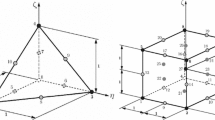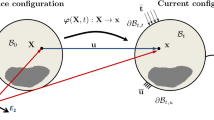Abstract
In this paper a generalized anisotropic hyperelastic constitutive model for fiber-reinforced materials is proposed. Collagen fiber alignment in biological tissues is taken into account by means of structural tensors, where orthotropic and transversely isotropic material symmetries appear as special cases. The model is capable to describe the anisotropic stress response of soft tissues at large strains and is applied for example to different types of arteries. The proposed strain energy function is polyconvex and coercive. This guarantees the existence of a global minimizer of the total elastic energy, which is important in the context of a boundary value problem.




Similar content being viewed by others
References
Humphrey JD (2002) Cardiovascular Solid mechanics: cells, tissues, and organs. Springer, New York
Fung YC (1993) Biomechanics mechanical properties of living tissues, 2nd ed. Springer, New York
Sacks MS (2000) J Elasticity 61:199
Holzapfel GA, Gasser TC, Ogden RW (2000) J Elasticity 61:1
Schmid H, Nash MP, Young AA, Hunter PJ (2006) ASME J Biomech Eng 128:742
Arruda EM, Boyce MC (1993) J Mech Phys Solids 41:389
Bischoff JE, Arruda EA, Grosh K (2002) J Appl Mech 69:570
Kuhl E, Garikipati K, Arruda EM, Grosh K (2005) Mech Phys Solids 53:1552
Lanir Y (1978) Biophys J 24:541
Kastelic J, Palley I, Baer E (1980) J Biomech 13:887
Freed AD, Doehring TC (2005) ASME J Biomech Eng 127:587
Gasser TC, Ogden RW, Holzapfel GA (2006) J R Soc Interface 3:15
Holzapfel GA, Gasser TC, Ogden RW (2004) ASME J Biomech Eng 126:264
Merodio J, Ogden RW (2002) Arch Mech 54:525
Merodio J, Ogden RW (2003) Int J Solids Struct 40:4707
Wilber JP, Walton JR (2002) Math Mech Solids 7:217
Chuong CJ, Fung YC (1983) ASME J Biomech Eng 105:268
Ball JM (1977) Arch Rat Mech Anal 63:337
Schröder J, Neff P (2003) Int J Solids Struct 40:401
Ball JM (2002) Geometry, mechanics, and dynamics. Springer, New York, p 3
Steigmann DJ (2003) Math Mech Solids 8:497
Itskov M, Aksel N (2004) Int J Solids Struct 41:3833
Itskov M, Ehret AE, Mavrilas D (2006) Biomech Model Mechanobiol 5:17
Balzani D, Neff P, Schröder J, Holzapfel GA (2006) Int J Solids Struct 43:6052
Itskov M (2007) Tensor algebra and tensor analysis for engineers with application to continuum mechanics. Springer, Berlin
Itskov M (2002) ZAMM 82:535
Truesdell C, Noll W (1965) Handbuch der Physik, vol III/3. Springer, Berlin
Ogden RW (1984) Non-linear elastic deformations. Ellis Horwood, Chichester
Zhang JM, Rychlewski J (1990) Arch Mech 42:267
Spencer AJM (1984) Continuum theory of the mechanics of fibre-reinforced composites. Springer Wien, p 1
Boehler JP (1977) ZAMM 57:323
Boyd S, Vandenberghe L (2004) Convex optimization. Cambridge University Press, Cambridge
Hill R (1968) J Mech Phys Solids 16:229
Müller S, Qi T, Yan BS (1994) Ann Inst Henri Poincaré Analyse non linéaire 11:217
Ball JM (1996) Bull Amer Math Soc 33:269
Holzapfel GA, Sommer G, Gasser CT, Regitnig P (2005) Am J Physiol Heart Circ Physiol 289:2048
Vande Geest JP, Sacks MS, Vorp DA (2004) ASME J Biomech Eng 126:815
Treloar LRG (1975) The physics of rubber elasticity, 3rd ed. Oxford University Press
Gent A (2004) Rubber Chem Technol 96:59
Author information
Authors and Affiliations
Corresponding author
Appendix
Appendix
Relations between the generalized structural tensors (15) and (18)
In the following, the relations between the weight factors w (r) i , i = 1,...,n, associated with principal material directions (18) and the factors v (r) i , i = 0,1,...,n, related to matrix and fibers (15) are given for some basic fiber constellations.
Unidirectional alignment of one family of fibers leads to transverse isotropy with respect to the fiber direction. Setting n = 1 in (15)1 and insertion of (14)1, (15)2 leads in view of (17)2 to
In a fiber reinforced material, orthotropy may be the result of different fiber configurations. We first consider the case where fibers are aligned in three mutually orthogonal fiber directions coinciding with the principal material directions, so that \(\user2{l}_i=\user2{m}_i, i=1,2,3\). Then, in view of (15,16,18) one obtains
A material with two orthogonal fiber families is likewise orthotropic, where the principal directions are given by the two fiber directions, so that \(\user2{l}_1=\user2{m}_1\) and \(\user2{l}_2=\user2{m}_2\), and the direction normal to the plane in which the fibers lie. The generalized structural tensors (18) are thus given by
Two equivalent families of fibers (v (r)2 = v (r)1 ) aligned in two arbitrary directions result in orthotropy. The principal material directions are given by the bisectors of the two fiber directions and the normal to the plane in which the fibers lie. The fiber directions can be expressed in terms of the principal material directions by
where the angle between the fibers is 2α. Hence, the generalized structural tensors read as
Finally, if there is a third fiber family i = 3 aligned normal to the plane spanned by the mechanically equivalent fiber families, we have
Additionally, superposition of several of the given cases may preserve the orthotropic material symmetry.
Rights and permissions
About this article
Cite this article
Ehret, A.E., Itskov, M. A polyconvex hyperelastic model for fiber-reinforced materials in application to soft tissues. J Mater Sci 42, 8853–8863 (2007). https://doi.org/10.1007/s10853-007-1812-6
Received:
Accepted:
Published:
Issue Date:
DOI: https://doi.org/10.1007/s10853-007-1812-6




